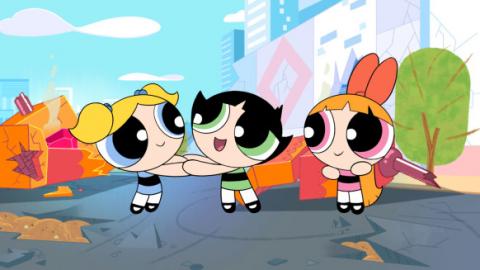THINGS WERE DIFFERENT the last time we hung out with The Powerpuff Girls. Back then, in the bygone 1990s, Dexter’s Laboratory and Ed, Edd, ’n’ Eddy dominated the Cartoon Network airwaves. And although those shows aimed to reach an audience beyond the Saturday morning cartoons crowd, they weren’t entirely concerned with presenting complex characters or, in the case of Powerpuff’s trio of heroes, going too far beyond the decade’s mantra of “Girl Power.”
Not anymore.
Almost two decades later, Cartoon Network’s most prominent shows—Adventure Time, Steven Universe, etc.—are also its smartest. Not only are the ’90s back (hello, DuckTales reboot!), but the idea that young women can be heroes is no longer a novelty. It is, in other words, the perfect time for Powerpuff Girls to come back.
The team behind the resurrected Powerpuff Girls, debuting tonight on Cartoon Network, knows this. Executive producer Nick Jennings (Adventure Time, SpongeBob SquarePants) and co-exec producer Bob Boyle (Clarence, The Fairly OddParents)—the duo that took over for the show’s original creator, Craig McCracken—were keen to make a show that spoke to its new audience and made the Girls modern, well-rounded heroes. “The original series was more of a bigger, broader comedy, and the girls relied on fighting monsters to move story along,” says Jennings. “Now a lot of the shows we produce are more sincere, character-driven stories.”
Who’s Got the Power?
That shift is apparent from the get-go. The first episode, “Princess Buttercup,” finds the girls at an elementary school rather than a kindergarten; that means older kids, which Boyle says lets you “deal with different social situations like cliques and clubs and different teachers and peer pressure.”
“Escape from Monster Island,” the second episode, features a conflict within the trio, as Buttercup (Natalie Palamides) and Blossom (Amanda Leighton) vie to accompany Bubbles (Kristen Li) to a concert for the girls’ favorite band, Sensitive Thugz. The girls were always defined in broad strokes—Blossom the leader, Bubbles the sensitive one, and Buttercup the tough one—but in their new incarnation they’re much more nuanced and deal with actual issues young girls face.
Upending the patriarchy was always a part of Powerpuff storylines, as trio demolished villain after cackling villain en route to saving the bumbling Mayor of Townsville (voiced by Tom Kenny). That’s not going to change. If anything, the new series will go further, providing commentary both nostalgic Millennials and younger viewers can grok. “For Man-Boy, there’s a lot of social commentary in a villain who says he wants Townsville to be Mansville, lined up against these super little girls,” says Boyle. “We explore those issues in a context that kids can get as well as adults.”
Obviously Powerpuff Girs has its female characters right there in the title, unlike most prestige animation series. But in ratcheting up the feminism of the show, it also helps that there are a fair number of women behind the scenes. Jennings and Boyle estimate that women make up between 50 and 65 percent of the crew on the new series, which more easily leads to stories that reflect the culture. “Animation in the past has generally been a white-male dominated field, but times are changing,” says Jennings. “If you’re working with just white males, it’s easy to fall into putting that type of character into the cartoon, but that’s not reflective of the world or our audience these days.”
Proof of that more enlightened approach to Powerpuff Girls is evident not just from the plots, but from the opening credits. The original theme riffed on the “What Are Little Boys Made Of” nursery rhyme by saying the titular Girls were made of “sugar, spice, and everything nice” along with the dreaded “Chemical X.” The new theme, by Seattle band Tacocat, starts there, but then cranks it up, depicting Buttercup, Blossom, and Bubbles as “three little girls saving the world before bedtime.” It’s a fitting anthem for a dynamic trio that just got a little more dynamic.


Spread the word